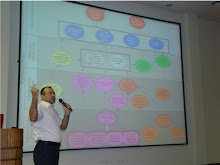Cultural alignment between partners is a necessary prerequisite for success (Bresnen and Marshall, 2000; Fuller et al, 2002). Our Projects induce long term relationships/partnerships between dispersed stakeholders with different cultural backgrounds. Subsequently, Cultural differences and alignment requirements should be assessed and their impact premeditated.
A good, ample practice we sighted was that presented by Thompson and Sanders (1998); first, they identified different levels of involvement that are possible within partnerships and which they referred to as competition, cooperation, collaboration and coalescence. Then they presented a framework whereby differences and similarities in the cultures of partnering groups can be assessed and evaluated as shown in the following figure. The red line we drew identifies those cultural indicators where improvement strategies are required in order to increase the level of maturity and/or alignment and hence the probabilities of success for the partnership arrangement
A good, ample practice we sighted was that presented by Thompson and Sanders (1998); first, they identified different levels of involvement that are possible within partnerships and which they referred to as competition, cooperation, collaboration and coalescence. Then they presented a framework whereby differences and similarities in the cultures of partnering groups can be assessed and evaluated as shown in the following figure. The red line we drew identifies those cultural indicators where improvement strategies are required in order to increase the level of maturity and/or alignment and hence the probabilities of success for the partnership arrangement
 Figure 9: The Cultural maturity-Alignment
Figure 9: The Cultural maturity-Alignment 
















No comments:
Post a Comment